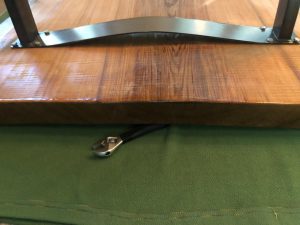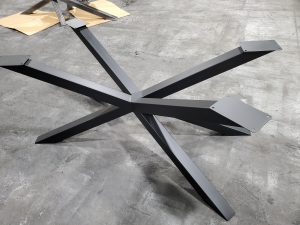The Importance of Slotted Holes on Metal Table Legs
Importance of Slotted Mounting Holes on Metal Table Legs
Depending on the manufacturer, you will see the term “slotted mounting holes” tossed around quite a bit. In short, the gold rule is that slotted mounting holes on a set of metal table legs or base are a necessity for any kind of wood tabletop, but can still be very useful for other types of top materials.
What are slotted mounting holes?

What is Wood Expansion and Contraction?
It is a somewhat known fact that wood expands and contracts with varying levels of humidity. The specifics of this can be pretty complicated, and a lot of variables play into the amount, and rate at which the wood expands and contracts, such as wood species, thickness, temperature, exposed edge, and any finish/stain applied to the wood. A good example of an extreme visual shown in
hyperlapse can be seen here from the Oregon State University:
Maple veneer shrinkage – OSU MediaSpace (oregonstate.edu)
A roughly 12″ square piece of thin maple was exposed to extreme variations of humidity and contracted about 3% in under 1 hour. This doesn’t sound like much, but on a standard 42″ wide top, that equates to over 1″ of contraction. The forces of wood expansion and contraction CAN NOT be stopped by a stout set of metal table legs or bracing. The wood is going to move, and it will find a direction to go, no matter how securely it is held down. “Bowing” and “cupping” or common terms in the woodworking industry that describe a piece of wood expanding or contracting in a non-uniform direction, which causes the wood to bow (think of a rainbow). Selecting a wood top from a woodworker who knows what they are doing is the most important step here. Instead of ignoring, or trying to prevent the wood from expanding or contracting, a good wood worker will build a tabletop that can expand and contract naturally and uniformly to maintain a flat profile.
So Why are Slotted Mounting Holes Important?
If a wood top is constructed and sealed properly, you should see expansion and contraction of less than 1%. Which for a 42″ wide top, still works out to almost 1/2″ of movement. It is crucial for any set of metal table legs or a metal table base being paired with a wood top to have allowance built into the mounting holes for the top to expand and contract. The golden standard we go by is to include slotted mounted holes on almost all of our products, to allow the wood and screw to slide side-to-side in the mounting hole to move with the expansion and contraction of the wood. If this is not taken into account with the build, the top will expand or contract and either break the mounting screws, split the wood, or bend and deform the metal base. There are thousands of manufacturers and builders of metal table legs and bases out there, and by far the most common mistake we see with their builds is the lack of consideration for expansion and contraction.
If you have a tabletop that is stone, acrylic, or some other material that the metal table legs or base will be mounted to, it’s not critical for the mounting holes to be slotted since the top is likely not going to expand or contract at all, but the slotted mounting holes can still be beneficial to allow for some error in the pilot hole or threaded inserts used in the top for the legs to mount to.
Are Slotted Mounting Holes the Only Solution?
We offer some products that are either impossible or impractical to get slotted mounting holes. Such as products with a top plate that is too thick to punch the hole out or plasma cut the slot. Or
some products don’t have a defined mounting orientation, so there is no way for us to predict the direction of the mounting slots. In these cases, an oversized round hole and a large washer can be used with the mounting screws. This same option can be applied for existing legs where the manufacturer did not account for expansion and contraction of a wood top. If you have a set of metal table legs with a screw hole size not much larger than the screw diameter, we strongly recommend drilling the holes to a larger diameter, at least 3/8″ when used with standard #8 or #10 wood screws. A fender washer sized for the screw size you are using can be used with the screw to get a good grip on the mounting plate of the metal base.




